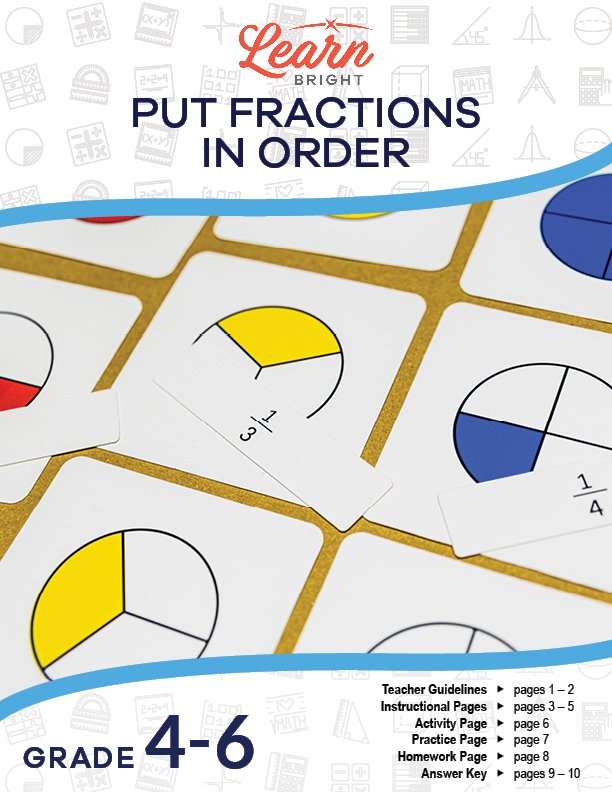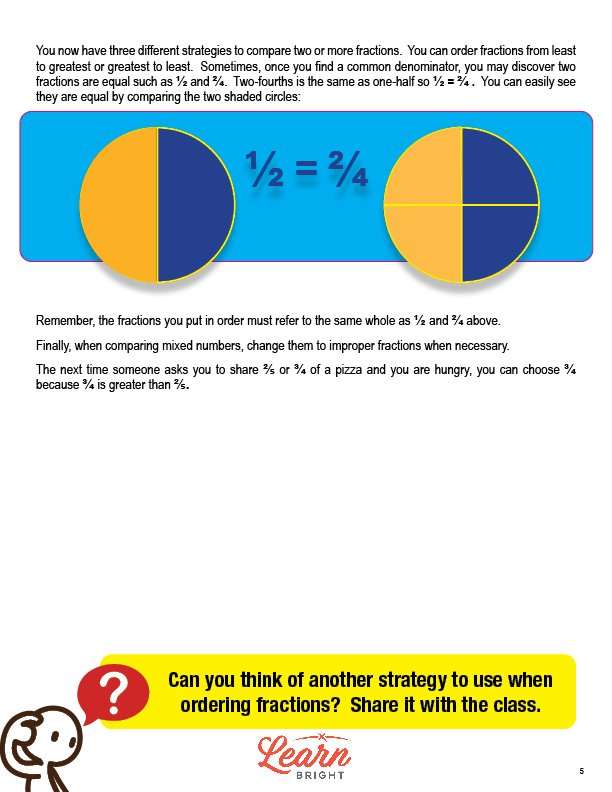Description
What our Put Fractions in Order lesson plan includes
Lesson Objectives and Overview: Put Fractions in Order teaches students how to compare fractions and put them in order. At the end of the lesson, students will be able to compare two fractions with different numerators and different denominators. This lesson is for students in 4th grade, 5th grade, and 6th grade.
Classroom Procedure
Every lesson plan provides you with a classroom procedure page that outlines a step-by-step guide to follow. You do not have to follow the guide exactly. The guide helps you organize the lesson and details when to hand out worksheets. It also lists information in the blue box that you might find useful. You will find the lesson objectives, state standards, and number of class sessions the lesson should take to complete in this area. In addition, it describes the supplies you will need as well as what and how you need to prepare beforehand.
Options for Lesson
Included with this lesson is an “Options for Lesson” section that lists a number of suggestions for activities to add to the lesson or substitutions for the ones already in the lesson. One optional adjustment to the lesson activity is to increase the number of fractions. For an additional activity, you can have your students create word problems to be shared with other students using comparison and ordering of fractions. For a hands-on demonstration, you can use manipulatives to show ordering of fractions. Finally, another optional addition to this lesson is to have your students create a poster showing the different strategies for ordering and comparing fractions with unlike denominators.
Teacher Notes
The teacher notes page includes a paragraph with additional guidelines and things to think about as you begin to plan your lesson. This page also includes lines that you can use to add your own notes as you’re preparing for this lesson.
PUT FRACTIONS IN ORDER LESSON PLAN CONTENT PAGES
Comparing Fractions
The Put Fractions in Order lesson plan includes three content pages. Students already know how to compare fractions with the same denominator. For example, if you cut a chocolate cake into four pieces, three-fourths of the cake is more than one-fourths of the cake. It’s easy to compare the sections of the cake using circle diagrams.
When fractions have the same denominator, all you need to do is compare the numerators. For example, 5/8 > 3/8, 1/3 < 2/3, and 7/16 = 7/16. Remember that the < symbol means less than, > means more than, and = means equal to.
It’s important to understand that the two fractions you’re comparing must refer to the same size whole. For example, you cannot compare slices of cake from two cakes that are different sizes.
If someone gave you one-half of a dollar, they are giving you 50 cents. However, if someone gave you one-half of $10, they are giving you $5. The fractions for both gifts are the same, ½, but the whole amounts are not the same. Therefore, the fraction of each amount is not the same and you cannot compare them as-is. The fractions being compared must refer to the same whole or total.
Compare Fractions with Unlike Denominators
It’s easy to compare fractions with unlike denominators. You can use several different strategies. First, find a common denominator between the fractions you want to compare. Second, compare the fractions to one-half (1/2). Third, use the same whole and draw pictures to compare the fractions. Let’s look at each of these strategies.
Strategy One
First, find a common denominator between the fractions you want to compare. Let’s look at an example to demonstrate how to use this strategy. Say you want to compare 3/4 and 5/8 by finding the lowest common denominator (LCD). This is easy because 4 can be divided into 8 evenly, so you can use 8 as the LCD. All you need to do is multiply the numerator and denominator of 3/4 by 2 to get 6/8. Then you can easily compare using the numerators: 6/8 > 5/8, so 3/4 > 5/8.
Let’s look at another example. Say you want to compare 3/5, 7/10, and 2/3. The LCD for the three denominators is 30. Next, we need multiply each fraction so that they all have 30 as their denominator. To do this, you multiply 3/5 by 6 to get 18/30, 7/10 by 3 to get 21/30, and 2/3 by 10 to get 20/30. Now, the three fractions you’re comparing are 18/30, 21/30, and 20/30. From least to greatest, 18/30 < 20/30 < 21/30. Using the original fractions, the comparison is 3/5 < 2/3 < 7/10.
Strategy Two
Second, compare the fractions to one-half (1/2). Let’s look at an example to demonstrate how to use this strategy. Say you want to compare 1/3 and 3/5. You know that 1/3 is less than 1/2 and 3/5 is greater than 1/2, so therefore 1/3 < 3/5. This is a great method to use when comparing two fractions.
Strategy Three
Third, use the same whole and draw pictures to compare the fractions. Let’s look at an example to demonstrate how to use this strategy. Say you want to compare 5/6, 2/3, and 4/9. You can do this by drawing three same-sized rectangles and dividing each rectangle into sixths, thirds, and ninths. Next, shade in the amount of each fraction. For 5/6, you shade in 5 of 6 parts of that rectangle. You can then compare the shaded areas of the rectangles and easily see which rectangles have larger and smaller shaded sections. For this example, when listing from least to greatest, you can see that 4/9 < 2/3 < 5/6.
Conclusion
You can now compare fractions using three great methods. Sometimes, when you find a common denominator, you may discover two fractions are equal, such as 1/2 and 2/4. You can easily double-check that they are equal using shaded circles.
Always remember that the fractions you’re comparing refer to the same whole! When comparing mixed numbers, remember to change them to improper fractions whenever necessary.
Now that you know how to compare fractions, if your friend asks you to share 2/5 or 3/4, you can choose 3/4 if you’re really hungry, because now you know that 3/4 is greater than 2/5!
PUT FRACTIONS IN ORDER LESSON PLAN WORKSHEETS
The Put Fractions in Order lesson plan includes three worksheets: an activity worksheet, a practice worksheet, and a homework assignment. You can refer to the guide on the classroom procedure page to determine when to hand out each worksheet.
POSTER ACTIVITY WORKSHEET
Students will work with a partner to complete the activity worksheet. Each pair will put a set of three common fractions in order and create a poster explaining the three strategies. Someone looking at the poster should understand each strategy. Their posters will be creative and colorful.
COMPARISON PRACTICE WORKSHEET
For the practice worksheet, students will first use <, >, or = to compare 20 pairs of fractions. They will also place seven sets of fractions in order from least to greatest.
PUT FRACTIONS IN ORDER HOMEWORK ASSIGNMENT
The homework assignment asks students to compare fractions using <, >, or =. For each fraction, they will also shade in a circle to match the fraction. They will also list sets of three mixed number from least to greatest.
Worksheet Answer Keys
This lesson plan includes answer keys for the practice worksheet and the homework assignment. If you choose to administer the lesson pages to your students via PDF, you will need to save a new file that omits these pages. Otherwise, you can simply print out the applicable pages and keep these as reference for yourself when grading assignments.









